Each new day, a list of tasks awaits us. Some of them are more interesting than others. Nevertheless, the importance of completing these tasks is undisputed, especially if they build on a daily basis.
There are so many of these so-called “best to-do list apps”, which claim to make your life easier. Although most of these apps stand up to the mark and can help to make things incredibly easy and organized, the criteria for their selection remains a puzzle.
Remember the milk
One of the most popular simple personal task management apps currently available. As the name suggests, Remember the Milk is designed for staying on top of life’s small to-dos. It’s powerful enough to let you organize task priorities, due dates, repeats, lists and tags, and get reminders via email, text and mobile notifications. You can also share your lists to keep friends and family in the loop, and integrate with Gmail, Google Calendar, Evernote and more.

TickTick (Android, Windows, macOS, iPhone and iPad, Web)
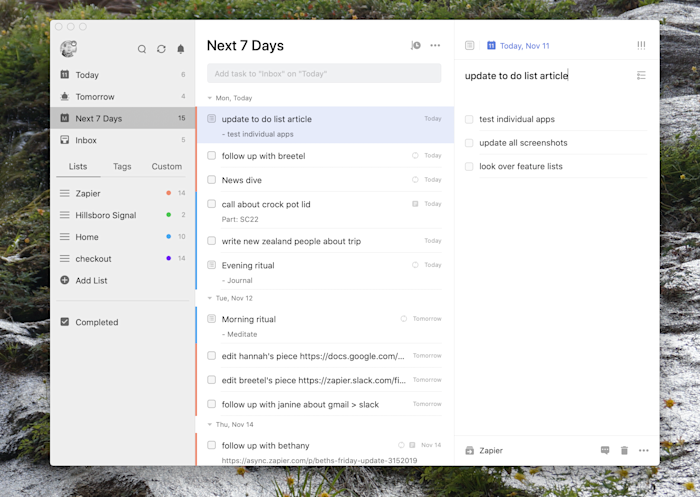
TickTick is a fast-growing to-do list app that offers a wide array of features on just about every platform you can imagine. Adding tasks is quick thanks to natural language processing. There’s also a universal keyboard shortcut offered on the desktop versions and pinned notifications and widgets on mobile, which makes it quick to add a task before getting back to what you’re doing. Tasks can be organized using lists, tags, and due dates, and there’s even the ability to add sub-tasks to any task.
TickTick offers all of this with apps that feel native—the macOS version is distinct from the Windows version, for example, in ways that make sense given the differences between those two systems. TickTick also offers a few features that are above and beyond what other apps offer. First of all, there’s a built-in Pomodoro timer, allowing you to start a 25-minute work session for any of your tasks. Second, there’s integration with various third-party calendars, allowing you to see your tasks and your appointments in one place, and even do some time blocking. There’s also a built-in habit-tracking tool, allowing you to review how many days you did or didn’t stick to your exercise and diet commitments. It’s a great collection of features, unlike anything else on the market.
Microsoft Todo
Microsoft To Do is a cloud-based task management app that lets you manage your tasks from a smartphone, tablet and computer. The smart daily planner helps you stay on track, and you can break tasks down into simple steps, add due dates, and set reminders, as well as share your list with friends and family.

Things (macOS, iPhone, iPad)
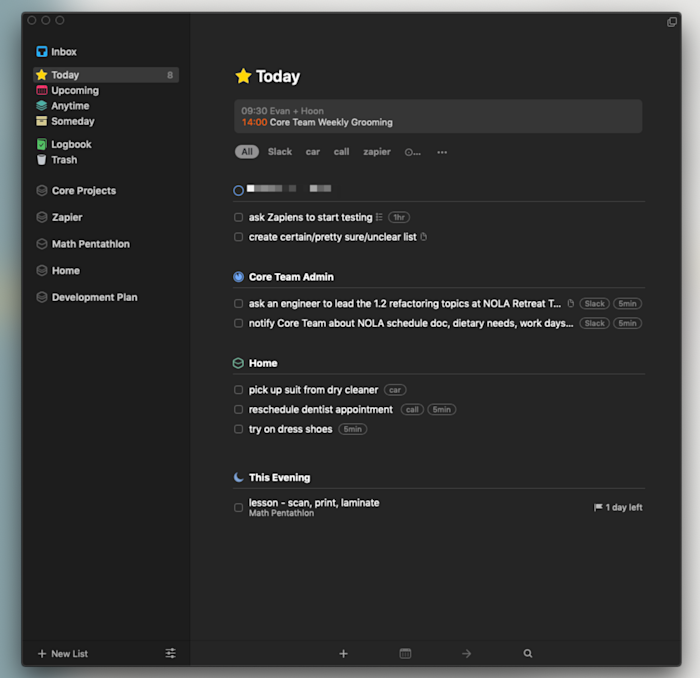
To-do list apps tend to fall into two categories: the complex and the minimalist. Things is somehow both.
That is about the highest praise I can give a to-do list app. This is an application with no shortage of features and yet it always feels simple to use. Adding tasks is quick and so is organizing them, but there’s seemingly no end of variation in ways to organize them. Areas can contain tasks or projects; projects can contain tasks or headers that can also contain tasks; even tasks can contain sub-tasks if you want. It sounds confusing, but it isn’t, which really speaks to how well Things is designed.
Other applications offer these features, but Things does it in a way that never feels cluttered, meaning you can quickly be done with looking at your to-do list and get back to whatever it is you’re doing. Combine this blend of functionality and beauty with features like a system-wide tool for quickly adding tasks, integration with your calendar so you can see your appointments while planning your day, intuitive keyboard shortcuts, reminders with native notifications, and syncing to an iPhone and iPad app.
The only downside here is the complete lack of versions for Windows and Android, though this decision is probably part of what allows the team to focus on making such a clean product. If you’re an Apple user, you owe it to yourself to try out Things.
Things price: $49.99 for macOS (15-day free trial), $19.99 for iPad, $9.99 for iPhone
Evernote
First and foremost an app for capturing and organising ideas, Evernote also helps you stay on top of your tasks by creating to-dos in your notes, which puts your jobs in context. It also removes the need to switch between notes and a dedicated task management app, which can interrupt your flow. You can even add due dates, reminders and flags to help you stay on track and ensure nothing gets lost.

OmniFocus (macOS, iPhone, iPad)
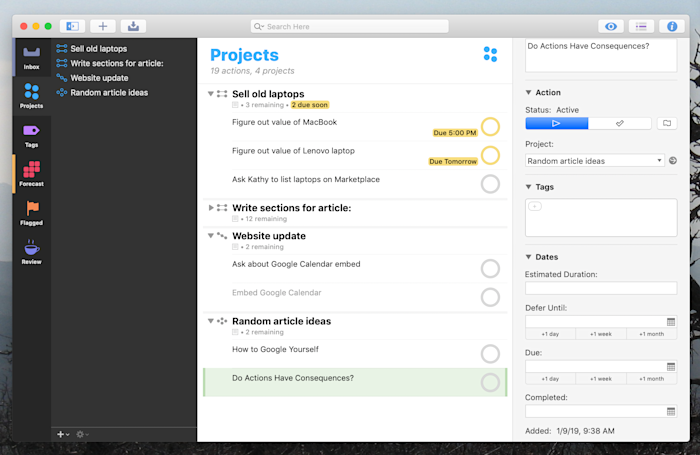
OmniFocus is nothing if not flexible. This Apple-exclusive application is built around the Getting Things Done (GTD) philosophy trademarked by David Allen, but an array of features means it can be used for just about any organizational system you can imagine. There are three different kinds of projects you can set up, for example, depending on whether you need to do tasks in a specific order or not. There are six main views by default, allowing you to organize your tasks by things like due date, projects, and tags. You can even add more views, assuming you have the Pro version.
You get the idea. OmniFocus is a power user’s dream, with more features than anyone can hope to incorporate into a workflow, which is kind of the point: if there’s a feature you want, OmniFocus has it, so you can organize your tasks basically any way you can imagine.
Syncing is offered only between Apple devices. There is a web version, currently in testing, but it’s intended for occasional usage away from your Apple machines more than anything else. Non-Apple users should look elsewhere.
OmniFocus price: From $99.99 per year for recurring plan. Also available as a one-time purchase from $39.99 (14-day free trial).
Timely
Unlike most team task management apps, Timely marries task organization and automatic time tracking, helping teams effortlessly visualize progress and see how long different deliverables actually take. Teams simply create or assign new tasks, and drag and drop them to their calendar to plan their schedule. With live progress bars, deadlines, and capacity calculations, everyone can plan work, track progress and manage priorities from one tool.

Habitica (Android, iPhone and iPad, Web)
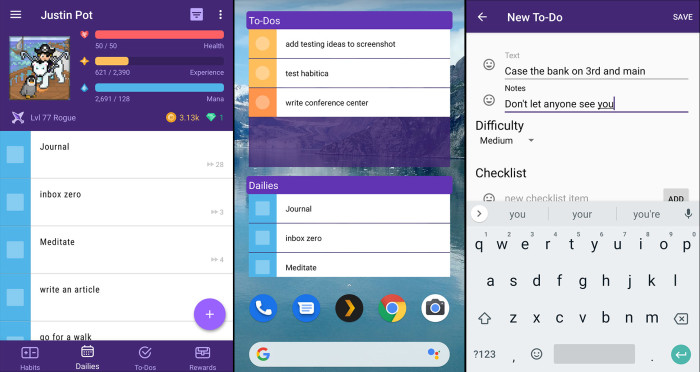
Games are fantastic at motivating mundane activity—how else can you explain all that time you’ve spent on mindless fetch quests? Habitica, formerly known as HabitRPG, tries to use principles from game design to motivate you to get things done, and it’s remarkably effective. You can add tasks, daily activities, and habits to a list. You also have a character, who levels up when you get things done and takes damage when you put things off. You can also earn in-game currency for buying offline rewards, such as a snack, or in-game items like weapons or even silly hats.
This is even better when you join a few friends and start a party. You can all fight bosses together, but be careful: fail to finish some tasks on time and your friends will take damage. If that doesn’t motivate you, nothing will.
What’s the downside? Habitica isn’t a great to-do list for managing long-term projects, so you might need something else for that. But if motivation is your problem, Habitica is well worth a spin.
Habitica Price: Free version available; paid version from $5/month
nTask
As a task management app that allows teams to collaborate, plan, analyze and manage everyday tasks, nTask is popular with both small businesses and individuals. It provides tools that enable collaboration between team members, and makes it easy to generate progress reports, assign tasks, set recurring tasks, and share files.

MeisterTask
One of the most popular task management tools for teams is MeisterTask, which provides all team members with an overview of work in progress, from conception to completion. The Kanban-style boards help digitalize workflows, and the Gantt-style timeline helps drive efficiency, ensure deadlines are kept, and keep teams aligned.

Todoist (Windows, macOS, Android, iPhone, iPad, Web)
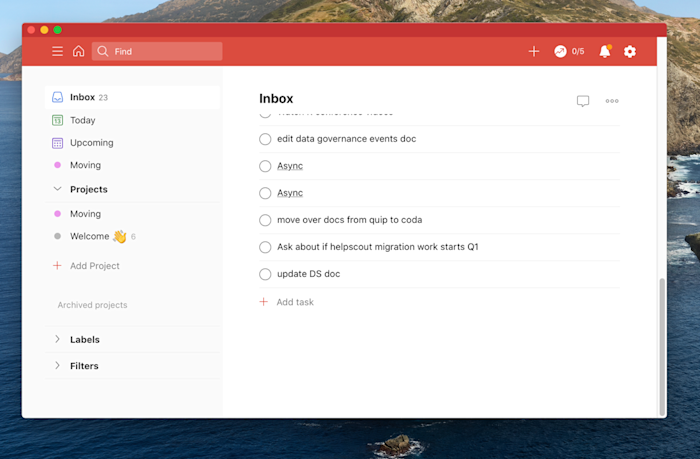
Todoist isn’t the most powerful to-do list out there. It’s also not the simplest. That’s kind of the point: this app balances power with simplicity, and it does so while running on basically every platform that exists. That’s a strong selling point—which is probably why Todoist is one of the most popular to-do lists right now, with over 10 million users.
Adding tasks was quick on every platform in our tests, thanks in part to natural language processing (type “buy milk Monday” and the task “buy milk” will be added with the next Monday set as your due date). You can put new tasks in your Inbox and then move them to relevant projects; you can also set due dates. Paid users can create custom filters and labels, and there are also some basic collaboration features.
Todoist is flexible enough to adapt to most workflows but not so complicated as to overwhelm. Overall, this is a great first to-do list app to try out, especially if you don’t know where to start.
Todoist price: Free version available; paid version from $3/month
Conclusion
There are days when you have tens of tasks to complete both at a professional and personal level. To keep your head over water you need to be on top of your game.
To make that happen what I have discovered over the years is that using a To-Do list app helps a lot.
